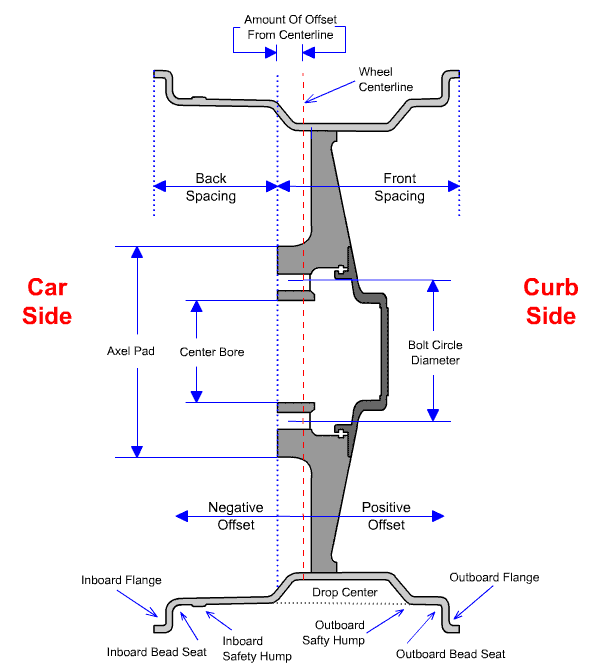Decoding Your Wheels: Wheel Rim Measurements Explained
:max_bytes(150000):strip_icc()/wheel_diagram_500-56a956223df78cf772a5fdd8.gif)
Ever wondered about those numbers and letters stamped on your wheel rims? They're not just random markings. They represent a precise language that speaks volumes about your wheels' dimensions and compatibility with your vehicle. Understanding this language is essential for safe driving, optimal vehicle performance, and even aesthetic appeal. This guide breaks down the complexities of wheel rim measurements, providing a clear and concise explanation for every driver.
Choosing the wrong wheel size can lead to a host of problems, from rubbing against the fenders to affecting your speedometer accuracy. It can also impact your car's handling and braking performance. By understanding wheel rim measurements, you can ensure a proper fit and maximize your driving experience. This understanding also empowers you to make informed decisions when upgrading your wheels or replacing tires.
Wheel rim measurements encompass several key factors. Diameter, typically measured in inches, represents the size of the wheel from one edge to the other, passing through the center. Width, also in inches, indicates the distance between the two inner edges of the rim where the tire beads sit. These two measurements are fundamental and often represented together, such as 17x7.5 (17-inch diameter and 7.5-inch width).
Beyond diameter and width, other critical measurements include offset, bolt pattern, and center bore. Offset, measured in millimeters, determines the wheel's position relative to the hub and affects how it sits within the wheel well. Bolt pattern refers to the number of lug holes and the diameter of the circle they form. The center bore is the diameter of the hole in the center of the wheel, which must match the hub on your vehicle.
The history of wheel rim measurement standardization is intertwined with the evolution of the automobile itself. As cars became more complex and diverse, the need for standardized measurements arose to ensure interchangeability and safety. Organizations like the Tire and Rim Association (TRA) play a crucial role in defining and maintaining these standards.
Benefits of Understanding Wheel Rim Measurements:
1. Safety: Correctly sized wheels ensure proper tire fitment, preventing issues like blowouts or loss of control. For instance, using a rim that's too narrow for the tire can lead to the tire bead detaching from the rim. 2. Performance: Choosing the right wheel dimensions optimizes handling, acceleration, and braking. Wider wheels can improve grip and cornering stability, while lighter wheels can enhance acceleration. 3. Aesthetics: Understanding measurements allows you to select wheels that enhance your vehicle's appearance. You can choose the right diameter, width, and offset to achieve the desired stance and look.
Action Plan for Checking Your Wheel Rim Measurements:
1. Locate the markings on your existing wheel. These are usually stamped on the back of the wheel.
2. Decode the markings using online resources or consult your vehicle's owner's manual.
3. When purchasing new wheels, ensure the measurements are compatible with your vehicle's specifications.Advantages and Disadvantages of Aftermarket Wheel Sizing
| Advantages | Disadvantages |
|---|---|
| Enhanced appearance | Potential rubbing issues |
| Improved handling | Speedometer inaccuracies if diameter changes significantly |
| Increased brake clearance | Possible ride harshness with lower profile tires |
Frequently Asked Questions:
1. What is wheel offset? Offset is the distance between the wheel's mounting surface and the centerline of the wheel. 2. What is bolt pattern? Bolt pattern refers to the number of lug holes and the diameter of the circle they form. 3. What is center bore? Center bore is the diameter of the hole in the center of the wheel. 4. How do I find my car's wheel measurements? Consult your owner's manual or check the markings on your existing wheels. 5. Can I use different sized wheels on the front and rear of my car? It's possible, but it can affect handling and stability. Consult a professional. 6. What are the risks of using incorrect wheel measurements? Risks include tire damage, poor handling, and potential safety hazards. 7. Where can I find information on wheel and tire compatibility? Online resources and tire shops can provide compatibility information. 8. Do I need to inform my insurance company about new wheels? It's generally a good idea to inform your insurance company about any modifications to your vehicle.
Tips and Tricks:
Use a wheel and tire calculator to visualize how different wheel and tire combinations will affect your car's appearance and performance. Consult with a tire professional for personalized recommendations.
Understanding wheel rim measurements is not just about knowing a few numbers; it's about ensuring your safety, optimizing your vehicle's performance, and making informed decisions. By taking the time to decipher these markings and apply this knowledge, you can transform your driving experience. Whether you're replacing your tires, upgrading your wheels, or simply want to understand your car better, a firm grasp of wheel rim measurements is a valuable asset. Don't underestimate the importance of these seemingly small details – they can make a big difference in your driving experience. Start by checking your own wheel measurements today, and empower yourself with the knowledge to make the right choices for your vehicle and your safety. This will allow you to enjoy a smoother, safer, and more enjoyable ride while maximizing your car’s potential. Understanding these measurements will not only help you choose the right wheels for your needs, but it will also give you the confidence to talk knowledgeably with tire professionals and make informed decisions about your vehicle’s maintenance and upgrades.
The special bond with my great aunt
Transform your home with sherwin williams exterior house stains
Normans miami beach experience luxury dining and hotel













